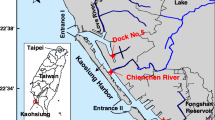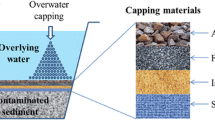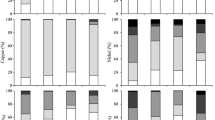Abstract
Purpose
Mobility and toxicity of heavy metals in river sediments seldom relate to their total concentrations, but to a greater extent depend on their distribution of speciation fractions. Ex situ washing of dredged sediment can effectively reduce the total metal contents, but it may transform metals into more mobile species. This study investigated the changes of the metal fraction distribution and the mobility risk of chemical washed river sediment.
Materials and methods
Batch chemical-enhanced washing experiments with different agents, including inorganic acids and salt solutions, chelating agents, and oxidizing agents, were conducted on the heavy metal-contaminated sediment collected from Shenzhen River in South China. The removal of Cr, Cu, Pb, and Zn from the sediment was evaluated, and the corresponding changes of metal fraction distribution were examined by using a sequential extraction procedure. The mobility of the remaining metals in the washed sediment was assessed by leaching extractability and compared to those in the original sediment.
Results and discussion
The results showed that inorganic acid washing effectively removed the majority of heavy metals, but the transformation of Cr, Cu, and Pb from the reducible fraction to the acid-extractable fraction significantly enhanced the mobility of the remaining metals in the washed sediment. Chelating agents such as EDTA and EDDS could efficiently extract Pb and Zn from the sediment, but to a less extent with Cu and Cr. Chelating agents also reduced the relative portions of Cr, Cu, and Pb associated with reducible fraction. Cu and Cr extraction would require the use of oxidizing agents such as H2O2 and Na2S2O8 that reduced their relative portions associated with the oxidizable fraction. Citric acid was only effective for Cr removal through dissolution of Fe oxides/hydroxides into which Cr(III) incorporates.
Conclusions
The feasibility of acid washing for sediment remediation should be reconsidered due to high mobility of residual metals, while H2O2 could be a promising additive for sediment remediation. However, a balance should be established between removing labile metal species and minimizing metal transformation.






Similar content being viewed by others
References
Apte AD, Verma S, Tare V, Bose P (2006) Extent of oxidation of Cr(III) to Cr(VI) under various conditions pertaining to natural environment. J Hazard Mater 128:164–174
Bacon JR, Davidson CM (2008) Is there a future for sequential chemical extraction? Analyst 133:25–46
Burbridge DJ, Koch I, Zhang J, Reimer KJ (2012) Chromium speciation in river sediment pore water contaminated by tannery effluent. Chemosphere 89:838–843
CCME (2001) Canadian sediment quality guidelines for the protection of aquatic life: Introduction. Updated In: Canadian environmental quality guidelines, 1999, Canadian Council of Ministers of the Environment, Winnipeg
Di Palma L, Mecozzi R (2007) Heavy metals mobilization from harbor sediments using EDTA and citric acid as chelating agents. J Hazard Mater 147:768–775
Dubois V, Abriak NE, Zentar R, Ballivy G (2009) The use of marine sediments as a pavement base material. Waste Manag 29:774–782
Ferrarese E, Andreottola G, Oprea IA (2008) Remediation of PAH-contaminated sediments by chemical oxidation. J Hazard Mater 152:128–139
Gu YF, Lin Q, ZL Y, Wang XN, Ke CL, Ning JJ (2015) Speciation and risk of heavy metals in sediments and human health implications of heavy metals in edible nekton in Beibu Gulf, China: a case study of Qinzhou Bay. Marine Pollut Bull 101:852–859
Harmsen J, Naidu R (2013) Bioavailability as a tool in site management. J Hazard Mater 261:840–846
HK ETWB (2002) Hong Kong Environment, Transport and Works Bureau: management of dredged/excavated sediment, Technical Circular (Works), No. 34/2002, ETWB(W) 209/32/96
Jiang G, Sharma KR, Guisasola A, Keller J, Yuan Z (2009) Sulfur transformation in rising main sewers receiving nitrate dosage. Water Res 43:4430–4440
Kim KJ, Kim DH, Yoo JC, Baek K (2011) Electrokinetic extraction of heavy metals from dredged marine sediment. Sep Purif Technol 79:164–169
Ko I, Chang Y, Lee C, Kim KW (2005) Assessment of pilot-scale acid washing of soil contaminated with as, Zn and Ni using the BCR three-step sequential extraction. J Hazard Mater 127:1–13
Kördel W, Bernhardt C, Derz K, Hund-Rinke K, Harmsen J, Peijnenburg W, Comans R, Terytze K (2013) Incorporating availability/bioavailability in risk assessment and decision making of polluted sites, using Germany as an example. J Hazard Mater 261:854–862
Kotas J, Stasicka Z (2000) Chromium occurrence in the environment and methods of its speciation. Environ Pollut 107:263–283
Kumpiene J, Lagerkvist A, Maurice C (2008) Stabilization of As, Cr, Cu, Pb and Zn in soil using immobilization. J. Waste Manag 28:215–225
Kuo S, Lai MS, Lin CW (2006) Influence of solution acidity and CaCl2 concentration on the removal of heavy metals from metal-contaminated rice soils. Environ Pollut 144:918–925
Labanowski J, Monna F, Bermond A, Cambier P, Fernandez C, Lamy I, van Oort F (2008) Kinetic extractions to assess mobilization of Zn, Pb, Cu, and Cd in a metal-contaminated soil: EDTA vs. citrate. Environ Pollut 152:693–701
Landrot G, Tappero R, Webb SM, Sparks DL (2012) Arsenic and chromium speciation in an urban contaminated soil. Chemosphere 88:1196–1201
Lei M, Liao BH, Zeng QR, Qin PF, Khan S (2008) Fraction distributions of lead, cadmium, copper, and zinc in metal-contaminated soil before and after extraction with disodium ethylenediaminetetraacetic acid. Soil Sci Plant. Anal 39:1963–1978
Li H, Shi A, Zhang X (2015) Particle size distribution and characteristics of heavy metals in road-deposited sediments from Beijing Olympic Park. J Environ Sci 322:28–237
Lin Q, Chen YX, Wang ZW, Wang YP (2004) Study on the possibility of hydrogen peroxide pretreatment and plant system to remediate soil pollution. Chemosphere 57:1439–1947
Magar VS, Martello L, Southworth B, Fuchsman P, Sorensen M, Wenning RJ (2008) Geochemical stability of chromium in sediments from the lower Hackensack River, New Jersey. Sci Total Environ 394:103–111
Mercurio P, Mueller J, Eaglesham G, Flores F, Negri A (2015) Herbicide persistence in seawater simulation experiments. Plus One DOI. doi:10.1371/journal.pone.0136391
Nystroem GM, Pedersen AJ, Ottosen LM, Villumsen A (2006) The use of desorbing agents in electrodialytic remediation of harbor sediment. Sci Total Environ 357:25–37
Ortega LM, Lebrun R, Blais JF, Hauslerd R, Drogui P (2008) Effectiveness of soil washing, nanofiltration and electrochemical treatment for the recovery of metal ions coming from a contaminated soil. Water Res 42:1943–1952
Pan K, Wang WX (2012) Trace metal contamination in estuarine and coastal environments in China. Sci Total Environ 421:3–16
Peng JF, Song YH, Yuan P, Cui XY, Qiu GL (2009) Review: The remediation of heavy metals contaminated sediment. J Hazard Mater 161:633–640
Perez-Novo C, Pateiro-Moure M, Osorio E, Novoa-Munoz JC, Lopez-Periago E, Arias-Estevez M (2008) Influence of organic matter removal on competitive and noncompetitive adsorption of copper and zinc in acid soils. J Colloid Interf Sci 322:33–40
Pociecha M, Lestan D (2009) EDTA leaching of Cu contaminated soil using electrochemical treatment of the washing solution. J Hazard Mater 165:533–539
Rauret G, Lopez-Sanchez JF, Sahuquillo A, Quevauviller P (1999) Improvement of the BCR three step sequential extraction procedure prior to the certification of new sediment and soil reference materials. J Environ Monitor 1:57–61
Reed B, Carriere P, Moore R (1996) Flushing of a Pb(II) contaminated soil using HCl, EDTA, and CaCl2. J Environ Eng 122:48–50
Rock ML, James BR, Helz GR (2001) Hydrogen peroxide effects on chromium oxidation state and solubility in four diverse, chromium-enriched soils. Environ Sci Technol 35:4054–4059
Tsang DCW, Hartley NR (2014) Metal distribution and spectroscopic analysis after soil washing with chelating agents and humic substances. Environ Sci Pollut Res 21:3987–3995
Tsang DCW, Olds WE, Weber PA (2013) Residual leachability of CCA-contaminated soil after treatment with biodegradable chelating agents and lignite-derived humic substances. J Soils Sediments 13:895–905
Tsang DCW, Yip ACK (2014) Comparing chemical-enhanced washing and waste-based stabilisation approach for soil remediation. J Soils Sediments 14:936–947
Tsang DCW, Zhang WH, Lo IMC (2007) Copper extraction effectiveness and soil dissolution issues of EDTA-flushing of contaminated soils. Chemosphere 68:234–243
Wang L, Kwok JSH, Tsang DCW, Poon CS (2015b) Mixture design and treatment methods for recycling contaminated sediment. J Hazard Mater 283:623–632
Wang L, Tsang DCW, Poon CS (2015a) Green remediation and recycling of contaminated sediment by waste-incorporated stabilization/solidification. Chemosphere 122:257–264
Wei YL, Yang YW, Lee JF (2005) Lead speciation in 0.1 N HCl-extracted residue of analog of Pb-contaminated soil. J Electron Spectrosc 144:299–301
Wu J (2012) Evaluation and application of typical methods for rainwater utilization of low impact development. Dissertation of Master, Harbin Institute of Technology
Wuana RA, Okieimen FE, Imborvungu JA (2010) Removal of heavy metals from a contaminated soil using organic chelating acids. Int J Environ Sci Technol 7:485–496
Yan DYS, Lo IM (2013) Removal effectiveness and mechanisms of naphthalene and heavy metals from artificially contaminated soil by iron chelate-activated persulfate. Environ Pollut 178:15–22
Yan DYS, Yip TCM, Yui MMT, Tsang DC, Lo IM (2010) Influence of EDDS-to-metal molar ratio, solution pH, and soil-to-solution ratio on metal extraction under EDDS deficiency. J Hazard Mater 178:890–894
Yoo JC, Kim EJ, Yang JS, Baek K (2015) Step-wise extraction of metals from dredged marine sediments. Sep Sci Technol 50:536–544
Yoo JC, Lee CD, Yang JS, Baek K (2013) Extraction characteristics of heavy metals from marine sediments. Chem Eng J 228:688–699
Zhang WH, Huang H, Tan FF, Wang H, Qiu RL (2010) Influence of EDTA-washing on the species and mobility of heavy metals residual in soils. J Hazard Mater 173:369–376
Zhang WH, Tong LZ, Yuan Y, Huang H, Qiu RL (2011) Metal mobility and fraction distribution in a multi-metal contaminated soil chemically stabilized with different agents. J Hazard Toxic Radioact Waste Manag 15:1–11
Zhang WH, Tsang DCW, Chen H, Huang L (2013) Remediation of an electroplating contaminated soil by EDTA flushing: chromium release and soil dissolution. J Soils Sediments 13:354–363
Zou ZL, Qiu RL, Zhang WH, Dong HY, Zhao ZH, Zhang T, Wei XG, Cai XD (2009) The study of operating variables in soil washing with EDTA. Environ Pollut 157:229–236
Acknowledgements
The authors wish to thank the National Natural Science Foundation of China (project no. 51208145) for the financial support of this study.
Author information
Authors and Affiliations
Corresponding author
Additional information
Responsible editor: Trudy J. Estes
Electronic supplementary material
ESM 1
(DOCX 21 kb)
Rights and permissions
About this article
Cite this article
Wang, H., Liu, T., Tsang, D.C. et al. Transformation of heavy metal fraction distribution in contaminated river sediment treated by chemical-enhanced washing. J Soils Sediments 17, 1208–1218 (2017). https://doi.org/10.1007/s11368-016-1631-y
Received:
Accepted:
Published:
Issue Date:
DOI: https://doi.org/10.1007/s11368-016-1631-y




